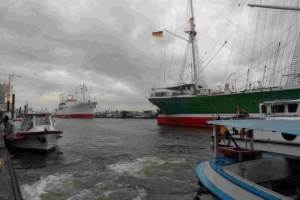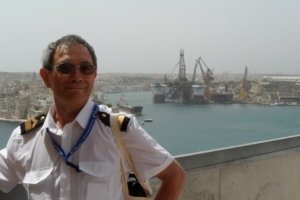Digital twins and AI versus “Black Swans”. Digital revolution in ports

 By Marek Grzybowski
By Marek Grzybowski
The IT and information revolution does not spare seaports. Industry 4.0 tools reach ports, which have long been a place not only for transhipment and refining of goods, but also for industrial activities of the highest quality. In fact, even since forever. Automated reloading devices and BoxBay high-bay warehouses supported by digital twins are becoming more and more common. For many years, containers in Hamburg have been moved by driverless vehicles and stored under the supervision of IT systems. Sensor systems control the movement of trains, cars and ships.
Real-time tracking systems for containers or their movements are becoming an integral part of port operations. These technologies not only ensure the safe flow of goods, but also play a key role in managing temperature-sensitive deliveries necessary for industries such as pharmaceuticals and the transportation of chips or smartphones.
Real-time cargo tracking was already possible over 20 years ago. Today, a level of perfection has been achieved using a system such as CARGOES Flow DP World.
– Innovative solutions, such as remotely controlled port cranes, contribute to the reconstruction of traditional port infrastructure – emphasize the directors of V&VCS.
With AI electric platform after terminal
But not only cranes are controlled by IT systems. For example, at the Hamburg HHLA terminal, container transport always follows the optimal route. Dr. Dennis Dreier, Senior Consultant, IT Strategy & Digitalization, HHLA explains that at the port, “AI programs optimize routes or automated management of container storage in storage yards. Based on calculations, it is determined how best to arrange the containers to achieve optimal use of the storage space.
– While many container terminals are illuminated at night like the streets of capital cities, electric platforms with containers glide in the dark at HHLA, moving silently between stacks of containers – said Maciej Brzozowski, representative of the Port of Hamburg in Poland, at one of the BSSC conferences.
– Thanks to Deep Learning, artificial intelligence can predict what means of transport the containers will be delivered to Burchardkai. The COOKIE (CONtainer Services Optimized by Artificial IntelligEnce) research project determined how the new technology allows detecting damage to containers. Based on the IT evaluation of the image, the operation of container cranes is also monitored – informs Dr. Dennis Dreier, Senior Consultant, IT Strategy & Digitalization, HHLA.
HHLA’s railway subsidiary, Metrans, intends to use artificial intelligence in train management. AI will automatically check over 100 different conditions and damage to freight wagons. This will make it easier to detect damage to wagons and locomotives and get trains back on the tracks faster.
More efficient use of technology and the associated conservation of resources will ultimately also contribute to the desired climate neutrality.
Virtual and real reality go hand in hand
In the field of container shipping, the integration of digital twins, artificial intelligence and IoT is already a reality. “Imagine a future where by 2035, 45% of container shipping is largely autonomous.
– Smart containers equipped with sensors provide real-time insight into the location and status of the shipment, ensuring precise and safe delivery – say Vinay Nyamati, Managing Director, V & V Comptech Systems (V&VCS) and Gnanesh Asagodu, Director-Engineering V&VCS.
And we are talking about a lot of responsibility for cargo and a lot of money. According to V&VCS executives, the global pharmaceutical cold chain industry is “valued at $73 billion annually.” This is where we witness digital transformation that uses blockchain and supports IoT.
– Temperature-sensitive medicines, including vaccines, are monitored using IoT temperature sensors placed in individual containers, creating an effective audit trail and enabling the prediction of environmental risks – emphasize Nyamati and Asagodu. For the automotive sector, they believe that integrating AI into container handling systems optimizes deliveries, reduces port delays and increases overall efficiency.
In the field of semiconductors, digital twins and artificial intelligence play a key role in building the resilience of production chains. We have often witnessed the suspension of production in production plants in Europe and Asia as a result of interrupted supplies of semiconductors or components installed in them.
AI technology attack on the “Black Swan”
AI technologies and digital tweens can mitigate the negative effects caused by the “Black Swan” effect. These included the Covid-19 pandemic, the blockade of the Suez Canal by the M/S Ever Given, the restriction of traffic through the Panama Canal, Russia’s attack on Ukraine, and the recent Houthi attacks. Although many people claim that this event could have been predicted.
The Black Swan event undoubtedly highlighted the vulnerability of supply chains and underlined the need to ensure their end-to-end transparency. – The term ‘from [shipping – MG] to [receiving – MG]’ is commonly defined as meaning visibility from node to node, door to door, from origin to destination or from manufacturer to end customer – states Mike Bhaskaran , Chief Operations Officer at DP World.
Lloyd’s List estimated in 2022 that more than $9 billion worth of goods passed through the 200-kilometer Suez Canal waterway each day. This means that goods worth approximately $400 million were moved through the Red Sea per hour.
– Even if your goods were worth just a thousandth of this amount and only 1% of this amount was affected, this would mean that the affected portion of inventory (working capital) would be close to PLN 96,000. dollars a day or about $35 million a year, Bhaskaran calculates.
This shows how catastrophic the effects of disruptions in the logistics chain caused by missile attacks in just one place on the globe are. Seaports must be prepared to bear the brunt of disruptions in global logistics networks. The breakdown in ocean routes is transferred through ports to local connections.
Digital twins in Livorno and Valencia
A technological revolution is underway in the ports of Livorno and Valencia. Mobile computing, AI analytics and IoT-enabled cloud computing are transforming and digitizing almost every sector. Funded for EUR 7.9 million, the iNEGIOUS project is a joint project of 21 partners that aims to accelerate digital transformation and the widespread implementation of IoT applications.
INGENIOUS is an EU-funded project that aims to redesign supply chains. The project will leverage some of the most innovative new technologies such as 5G, big data, artificial intelligence, blockchain, virtual and augmented reality to build a complete supply chain management platform.
Since 2016, the Port of Livorno has been working on implementing technological infrastructure using 5G communication, artificial intelligence and digital twin. Livorno is a major regional port on the northwest coast of Italy, close to the historic city of Pisa. This is a universal port. It has a capacity of approximately 30 million tons of cargo and 600 thousand tons. TEU. It is an important transport hub for Italian Ro/Ro traffic.
Virtual sea port
Each area in the port was modeled virtually to replicate physical elements, such as the port area for storing general cargo, containers and other cargo.
Accurate and efficient storage and location of goods is fundamental to logistics operations in a busy container port. With WDR cameras, you can record and stream every aspect of ongoing operations. For example, cargo is tracked as it moves from one area to another, and new position data is recorded in operational control systems. The cameras work in all weather conditions and at various times of the day.
The Port of Livorno is taking another step forward in technology with the inclusion of virtual reality (VR) applications. This enables operators to virtually navigate inside the Digital Twin and gain a complete overview of the entire digital port area.
Awake.AI is part of the project involving the implementation of artificial intelligence in the ports of Livorno and Valencia. Its task is to optimize truck service times in the ports of Valencia and Livorno. Awake.AI will develop predictive models and optimization of truck dwell times using the port area and vehicle tracking sensors, data from port community systems and data from the automatic vessel identification system.
– These types of predictive models are necessary not only to manage congestion in the port area, but also to understand the factors influencing the extension of service times. Awake.AI’s predictive models are important and essential for optimizing port operations.” – says Dr. Jussi Poikonen, vice president of artificial intelligence and analytics at Awake.AI.
Maritime logistics is at the forefront of bringing the digital future to life. The synergy of artificial intelligence, IoT, satellite systems, VR and digital twins is transforming more than just logistics, ports and container transport.
The technology mix also changes logistics activities in intermodal transport, affects the management of warehouses and logistics centers, determines production logistics, store delivery logistics, and even retail courier services. Let’s hope that digital twins and AI will make it possible to repair in ports what the “Black Swans” have done on sea routes.
